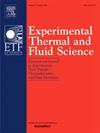Experimental study of two and three-phase steady flows in inclined rising pipes
IF 2.8
2区 工程技术
Q2 ENGINEERING, MECHANICAL
Experimental Thermal and Fluid Science
Pub Date : 2025-02-09
DOI:10.1016/j.expthermflusci.2025.111430
引用次数: 0
Abstract
This paper presents, interrelates, and discusses the main experimental results that have been obtained in three experimental campaigns performed in the Laboratory of Hydraulics, Water Resources and Environment (LHWRE) of Coimbra University in three different configurations of an installation that was built and developed for the study of steady multiphase flows in inclined rising pipes. The first and second configurations, working in pipe steady flow, were prepared to allow original measurements and innovative studies about the liquid flow rate increase, keeping the total head at an upstream inlet chamber of a subsystem initially ruled by gravity, and the gain of total head at the chamber, for given initial liquid flow rates, both due to the air-lift effect caused by gas–liquid two-phase flows in two inclined rising conduits of 35 mm transparent plasticized PVC and of 94.5 mm LDPE. The third configuration was prepared to allow original and innovative measurements and studies about the solids transport in liquid–solids two-phase flows and gas–liquid–solids three-phase flows, both accomplished in an inclined rising 84 mm transparent acrylic pipe, simulating both steady turbulent flows initially governed by gravity and forced in conventional pumping systems. The results of the experiments performed with air, water, sand and fine gravel, with air flow rates between about 0.5 and 4.5 L/s, water flow rates up to about 9 L/s and granular material between 0.425 mm and 7.20 mm show that the presence of a gas phase in steady upward multiphase flows in an inclined pipe improves expressively both the flow performance of the liquid phase and the solids transport, avoiding, in particular, the sedimentation of solid particles. In large municipal or intermunicipal wastewater systems, the gas phase may be the air or oxygen required for sulfide control, which may be injected in steady flow in the base of the rising pipes. The installation may be adapted to transport other fluids, like hydrocarbons, muds from mining or dredging works, for example, or sludge from wastewater treatment plants, developing and expanding the main basic conclusions obtained to a relevant and wide field of several practical applications.
倾斜上升管内两相及三相稳态流动的实验研究
本文介绍并讨论了科英布拉大学水力学、水资源和环境实验室(LHWRE)为研究倾斜上升管道中多相流的稳定流动而建造和开发的装置的三种不同配置所进行的三次实验活动的主要实验结果。第一种和第二种配置在管道稳定流中工作,目的是对液体流速的增加进行原始测量和创新研究,保持最初受重力作用的子系统上游入口室的总水头,以及在给定的初始液体流速下,由于气液两相流在 35 毫米透明塑化聚氯乙烯和 94.5 毫米低密度聚乙烯的两个倾斜上升管道中产生的气升效应而导致的入口室总水头的增加。第三种配置是为了对液固两相流和气液固三相流中的固体输送进行原创性和创新性测量和研究而准备的,这两种流动都是在一个倾斜上升的 84 毫米透明丙烯酸管道中完成的,模拟了最初由重力控制的稳定湍流和传统泵送系统中的强制湍流。实验对象包括空气、水、沙子和细砾石,空气流速约为 0.5 至 4.5 升/秒,水流速最高约为 9 升/秒,颗粒材料的粒径在 0.425 毫米至 7.20 毫米之间,实验结果表明,在倾斜管道中稳定向上的多相流中,气相的存在明显改善了液相的流动性能和固体输送,尤其是避免了固体颗粒的沉积。在大型城市或城市间污水处理系统中,气相可以是控制硫化物所需的空气或氧气,可以在上升管道的底部稳定注入。该装置还可用于输送其他流体,如碳氢化合物、采矿或疏浚工程产生的泥浆,或废水处理厂产生的污泥,从而将获得的主要基本结论发展和扩展到多个实际应用的相关和广泛领域。
本文章由计算机程序翻译,如有差异,请以英文原文为准。
求助全文
约1分钟内获得全文
求助全文
来源期刊

Experimental Thermal and Fluid Science
工程技术-工程:机械
CiteScore
6.70
自引率
3.10%
发文量
159
审稿时长
34 days
期刊介绍:
Experimental Thermal and Fluid Science provides a forum for research emphasizing experimental work that enhances fundamental understanding of heat transfer, thermodynamics, and fluid mechanics. In addition to the principal areas of research, the journal covers research results in related fields, including combined heat and mass transfer, flows with phase transition, micro- and nano-scale systems, multiphase flow, combustion, radiative transfer, porous media, cryogenics, turbulence, and novel experimental techniques.
 求助内容:
求助内容: 应助结果提醒方式:
应助结果提醒方式:


